Used to straighten teeth. If you are still shown braces. Can you straighten your teeth at home?
Not correct position teeth is a problem a large number people, which is solved with the help of various orthodontic appliances.
Modern methods of straightening teeth include not only the use of braces, but also many other designs that differ from each other in cost and principle of action.
Are there alternative ways?
Correction without the use of braces is possible, but there is one caveat - the treatment will be effective only if small deviations in the formation of the dentition.
Usually, alternative methods alignments are shown in the following cases:
- violation of the process of swallowing or breathing;
- a slight deviation in the location of one or more crowns;
- abnormal development of bite;
- prevention of the appearance of crooked teeth in children under 12 years of age;
- reluctance to install braces by both adults and children.

Regardless of which method of correction the patient prefers, the final choice should be made only by the dentist.
The specificity of alignment in adults
Alignment of crowns at home in adulthood has certain specifics. Treatment without braces in adults has advantages in price, but takes quite a long time, since the jaw bones have long since completed their formation.
In addition, adults often present with problems such as fragility of crowns and severe atrophy bones, which greatly complicates the treatment process.
AT this case alternative alignment methods can be used for mild curvature. Most often, aligners, lumineers and veneers are used to correct teeth in adults.
Features of correction in children
The optimal period for orthodontic treatment in children and adolescents is between the ages of 5 and 12 years, when the jaw bones are still malleable for correction.
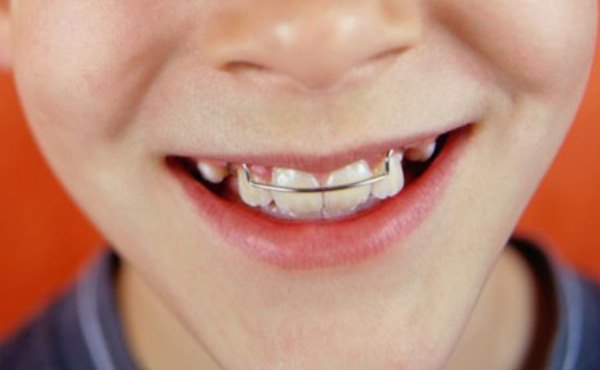
Alternative teeth straightening in children is best option, since, unlike braces, it eliminates primary cause curvature.
The choice of method is carried out by the dentist based on the causes of the anomaly and the characteristics of the development of the child:
- For example, trainers are not suitable for children who talk a lot.
- In the presence of bad habits, labial metal bumpers are used.
- To correct the position of the front teeth, expand or narrow the dentition, plates are recommended.
Overview of popular options
Removable orthodontic appliances are alternative methods of correction. They are differ from each other in appearance, purpose and cost.
Aligners (caps)
Aligners are one of the more expensive treatment options without braces, as they are only made in the USA. In the laboratory, using special 3D technology, an exact model of the jaw is recreated before and after treatment.
Based on this, from 10 to 50 aligners are formed by pressing for a phased correction. Caps are made of completely transparent hypoallergenic material.
The high price is justified by the fact that, as a result, the shape of the aligners repeats in detail the contour of each crown, tightly adhering to their surface.
Teeth straightening with mouth guards in both adults and children based on the principle of gradual pressure on the teeth which is ensured by regularly changing the aligners.
This technique has a lot benefits:
- getting used to the aligners takes only a few hours;
- straightening takes place without discomfort;
- undemanding in care.
Among shortcomings correction by caps, one can single out the duration of treatment and the high cost.

For wearing aligners, there are the following testimony:
- mild crowding of crowns;
- cross bite type;
- diastema;
- abnormal length of some teeth;
- uneven placement of crowns.
Contraindications:
- periodontal pathology in the acute stage;
- anomalies in the development of the jaw;
- somatic diseases in severe form;
- destruction alveolar process more than half of the root.
Recovery correct form The dentition must wear an aligner for at least 20 hours a day. It can only be removed when eating and brushing your teeth.
Cap replacement must be done in a timely manner. As a rule, this happens once every 10 or 15 days.
While wearing the caps, they are treated once a day with aseptic solutions.
Elastopositioners. Trainers
Trainers are used primarily to correct removable and early occlusion. Treatment with elastopositioners is started at the age of 5, when the crowns are still moving well.
Correction with trainers requires constant dental monitoring. To do this, every 2 months the doctor should conduct a preventive examination of the results of treatment.
Elastopositioners differ in certain benefits:
- for the manufacture does not require preliminary removal of casts;
- profitability;
- use does not require any skills.
Flaws:
- a long period of addiction;
- feelings of discomfort during treatment;
- trainers are painted during use.
Elastopositioners are made of medical hypoallergenic silicone and polyurethane.
Depending on the material used there are several types of trainers:
- hard;
- soft;
- combined.
For treatment, the trainer is selected using a special ruler. Large devices are used for crowded crowns, small ones for diastema.
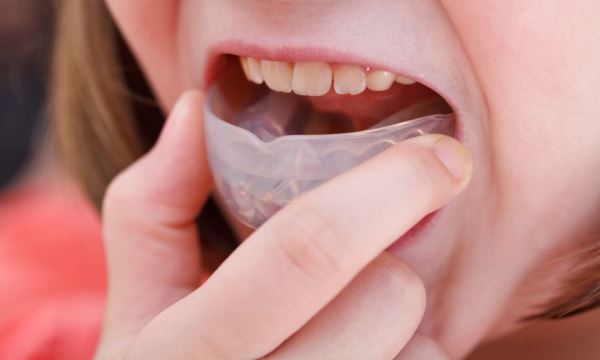
The main goal of trainers is correction of the following pathologies:
- hyperactivity of the muscles of the chin;
- respiratory failure;
- slight displacement of the crowns;
- deviations in the growth and development of the jaw;
- non-closure of the dentition.
Contraindications to wearing elastopositioners in most cases are relative:
- mesial bite;
- deviation from standard position middle line 3 mm or more;
- rotation in a complex form;
- open bite;
- diseases of ENT organs in the acute stage.
In order for the treatment to be successful, it is necessary to wear trainers for 1-2 hours during the day and put them on for 6-8 hours at night. The wearing time can be increased at the request of the patient.
The whole process treatment can be divided into 3 stages:
- Wearing the initial soft model. This stage lasts up to 8 months, during which there is a gradual adaptation to the device.
- Using the final rigid model for 8 months, which has a stronger effect on crowns.
- The use of retainers to consolidate the effect.
Trainers are a simple design that does not require special care. It is enough just to regularly clean them with soap and rinse under the pressure of water.
The device should be stored in an individual plastic container.
Veneers and Lumineers
These correction tools cannot restore the correct position of the crowns, but they allow you to visually correct the appearance of the dentition.
Veneers and Lumineers are thin plates made of ceramic. They are superimposed on the teeth in the smile zone, correcting their shape and color on long years. Distinctive feature of these overlays is that the installation is carried out in one visit.
Veneers and lumineers have a significant difference in price. Lumineers are much more expensive, as they are made using patented technology only in the USA.
It should be noted that veneers and lumineers are able to hide only mild defects in the dentition.
Veneers and lumineers have mass benefits:
- it is possible to hide pronounced defects without traumatizing crowns, for example, diastema;
- the ceramics used for manufacturing are resistant to abrasion;
- during use, the lining does not change the initial color;
- the installation procedure is painless.
disadvantage This option is the fragility of the plates and their peeling from the crown.
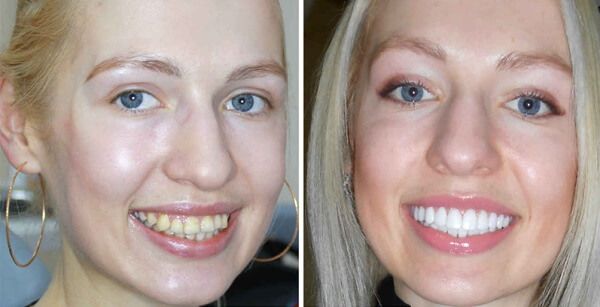
There are some differences between veneers and lumineers. Lumineers are several times thinner than veneers, which determines the advantage of their installation. Lumineers do not require pre-preparation to fix them.
When installing veneers, a small grinding of crowns is one of the mandatory steps in the procedure.
Main indications for the application of veneers or lumineers are:
- darkening of tooth enamel;
- increased abrasion of enamel;
- fluorosis;
- crown defects: chips, cracks;
- diastema, trema;
- underdevelopment of teeth;
- slight displacement or crowding.
Overlay installation cannot be carried out in the following cases:
- carious lesions of crowns;
- too much thin layer enamels;
- the presence of large fillings.
Linings are installed for 5-10 years, but can last much longer with proper care.
After installing veneers or lumineers hygiene oral cavity required to pay Special attention . All procedures must be thorough and timely. Need to apply additional funds cleansing: conditioners, threads.
Very hard foods such as nuts or seeds should be avoided.
Records
Plates are removable retainers, which were originally used as a fixing element after wearing braces. Now they are used to correct the position of one or two teeth.
Records consist of several parts: a palatal plate and a metal arc. Straightening occurs due to constant pressure arc, tightly covering curved crowns.
This design is made of flexible plastic and titanium. In some cases, nickel is used for the arc. Both materials have "shape memory" and always take the position given to the arc during manufacture.
To benefits plates include:
- low cost;
- wearing comfort;
- manufacturing speed.
disadvantage this option is:
- the impossibility of correcting serious deficiencies;
- the daily wearing period lasts at least 22 hours.
Plates for the correction of teeth have many modifications, each of which is selected depending on the cause of the anomaly. In addition, differences are noted in the color of the structure.
You can pick up a plate not of a classic pink hue, but multi-colored. Such designs are especially successful in children.
Testimony for the application of plates are:
- crown reversal;
- abnormal arrangement of single teeth;
- crowding;
- diastema.
Contraindications:
- abnormal position of a large number of crowns;
- periodontal disease.
Wearing a correction plate lasts from 6 months to 2 years. The term will directly depend on the age of the patient.
During this period, the structure can only be removed for 2 hours a day. When eating and brushing your teeth, the plate must also be removed. At the first time of using the device, the patient may experience discomfort in the area of straightened crowns, which disappears as you get used to it.
Throughout the treatment special attention should be paid to the care of the plate. Before use, it should be washed under the pressure of water. After use, be sure to clean with a brush and soap or paste. At least once a week it is necessary to wash the structure with an aseptic solution.
View the expert's opinion on choosing alternative ways to align teeth in children in the video:
Treatment results
Despite the fact that many consider alternative methods of bite correction to be ineffective, the results of treatment prove the opposite.
With a slight anomaly in the formation of the dentition using alternative options the following results can be achieved:
- lengthen or shorten the dentition;
- reduce the tone of the muscles of the jaw apparatus;
- return the correct position to the crowns;
- align the length of the teeth;
- correct overbite and occlusion.
A positive result can only be obtained by observing the wearing mode specified for the device used. In case of non-compliance with the mode of wearing and elementary rules hygiene correction may be delayed or not give results at all.
It is possible to install removable type structures only if there is confidence in proper conduct treatment.
If you find an error, please highlight a piece of text and click Ctrl+Enter.
There are many ways to correct misaligned teeth in orthodontics. The most popular of them is the installation of a bracket system.
Structures of this type have their drawbacks and contraindications. How to straighten your teeth without braces? What methods are used for this?
How earlier patient notices the violation and consults with an orthodontist, the more ways is there to solve the problem. Doctors believe optimal age to start the correction of the dentition - 12 years.
By this time, the jaw is formed, but still has little mobility. In adulthood, it will take more time and effort to correct violations.
An alternative to braces is offered in cases of:

- slight curvature of the dentition;
- the presence of gaps between the teeth;
- elimination of bad habits in children - sucking thumb, biting the lower lip;
- correction of irregular breathing rhythm, swallowing difficulties;
- prevention of curvature of teeth in children under 12 years of age;
- bite correction;
- the patient does not like this method of correction.
How to straighten your teeth without braces?
If a child's bite is monitored from an early age, there will be no problems. The task of parents is to wean children from bad habits. The use of pacifiers after a year leads to defects in the dentition, twisting of the teeth and malocclusion.
With an existing problem, many expect the teeth to straighten themselves, but this does not always happen. There are several types of designs that are recommended for young children.
AT early age children are easier to persuade to correct violations with the help of structures. After all, teenagers are often afraid of ridicule, criticism and do not agree to wear corrective devices.
Can you straighten your teeth yourself?
Aligning teeth without braces is possible, but for example, without specialized devices and orthodontist control malocclusion, torsion, curvature of crowns cannot be corrected.
If you make a design yourself, it is not a fact that it will help to cope with the problem.
All devices that correct violations are made from a special material that is safe for the body. They take into account all the features of the structure of the jaw.
At home, without suitable equipment, it will not be possible to achieve such characteristics. You can ruin your teeth to the point that you have to remove them.
However dental tissue very strong: without orthodontic structures, straightening teeth without braces is often impossible, but it all depends on each specific situation. AT dental practice among the patients there were attempts to correct the situation with the help of improvised means, which led to a long and expensive treatment.
O hygiene care look after the oral cavity.
How to straighten your teeth at home?
Modern technologies allow you to adjust the dentition at home. The first step is to visit an orthodontist for a checkup. He will choose the best solution to the problem. Often patients refuse to correct violations with braces, especially adults. Sapphire braces are transparent and almost invisible on the teeth, but many exclude this option due to the high cost of construction.
How to fix crooked teeth without braces?
It is important to note that there are cases in which wearing braces is in principle contraindicated:

- Absence of a large number of teeth. The problem is relevant for adult patients.
- Diseases nervous system. The patient can disrupt the course of treatment and even harm health. Such diseases include: schizophrenia, paronoia, neuroses, psychoses.
- Disruptions in the work of the endocrine and immune systems. They also include diabetes. During sickness bone and blood vessels become thinner. Wearing braces increases the risk inflammatory processes and weakening of the ligaments holding the tooth in the socket. This leads to thinning of the crown. There is a possibility of missing teeth.
- Diseases of bones.
- Pathologies circulatory system – poor clotting, leukemia.
- Diseases of the heart and blood vessels.
- Any degree and type of tuberculosis.
- Venereal diseases.
- Oncology.
There are also relative contraindications.
Braces can be placed when the following problems are fixed:
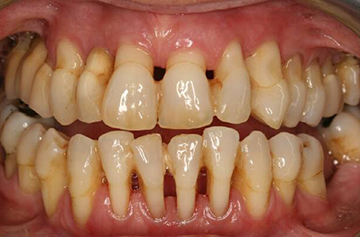
- Gum diseases: periodontal disease, periodontitis. The teeth will not withstand the extra load and will begin to break down.
- There is no possibility to carry out special hygiene. Braces must be carefully monitored. If you do not follow the rules for caring for them, plaque accumulates in hard-to-reach areas. This leads to caries.
- Allergy to the materials from which the structure is made.
- Bruxism is the grinding of teeth during sleep. Braces are replaced with a mouth guard.
- Diseases of the temporomandibular joint. Wearing braces with these disorders impairs the functioning of the jaw.
If there are contraindications, the orthodontist offers the patient other design options. Most of the methods are universal - suitable for both children and adults.
During the examination, the specialist will assess the condition of the teeth. Before correction, tartar is necessarily removed, caries is treated. Then choose the type of construction.
"Home conditions" means that the patient performs necessary hygiene corrective structures on their own, without regular visits to the doctor. This feature is an advantage over braces.
Almost all braces require constant supervision by a specialist. This is not always convenient. In addition, it is expensive, because. adjustments are carried out mainly by private clinics.
Teeth Straightening Methods
There are enough options for replacing braces. Each of them has its own focus and functionality.
In adults
With a slight curvature of the teeth, mouthguards are used. The bite cannot be corrected by this method. They are used to fix the result after wearing braces. Mouthguards are transparent caps. They are put on crowns.
To correct defects also use:

- veneers;
- composite restoration;
- elastopositioners;
- records.
In children
It is much easier for a child to correct violations, because. the formation of the jaw has not been completed. Correction is chosen based on the characteristics of the development of the jaw apparatus. Up to 12 years, sparing techniques are used. Since the jaw is not yet formed, any impact can lead to both positive and negative results. Complex structures are used in adolescence They are not suitable for small children.
Prevention of milk and removable dentition includes measures that prevent pathologies of the dentition:
- Prevention of bad habits: sucking fingers, improper swallowing, the location of the tongue between the teeth.
- Massage gums during teething and initial stages growth.
- Breath control. Prevention contributes to this colds, as well as timely treatment runny nose.
- Crown height correction. It is carried out by grinding the bumps.
- Monitor the posture and position of the child during sleep.
- Myogymnastics - exercises for the development of the muscles of the jaw apparatus. Suitable not only for prevention, but also for the correction of violations.
For the correction of teeth for children of preschool and younger school age orthodontists recommend sparing designs aimed at solving the problem:
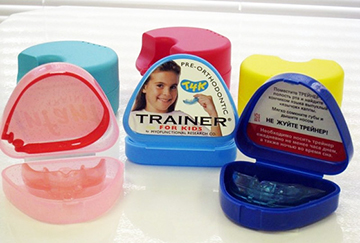
- Lip bumpers. Suitable for getting rid of bad habits, preventing malocclusion. Functions of the device - reduces the pressure of the jaw muscles on the teeth, reduces the activity of the muscles of the chin, lengthens dental arch. They are worn by children up to 5 years. Appearance- metal arc.
- Stretch plates. The task of the adaptation is to correct the bite on early stage pathology. As a result of the pressure of the plates, the teeth take their original position. They have a plastic base on which a metal arc is attached. Stretching plates are used when milk teeth have changed and permanent ones have grown.
- Trainers. This device is used in cases: speech disorders, to control swallowing, in case of incorrect position mandible and to straighten teeth. Moreover, trainers not only correct the bite, but also eliminate the cause of the pathology. Appearance - silicone case. Suitable for children from 5 years old.
Many dentists take special role gymnastics, because with its help, pathologies are eliminated without the use of orthodontic appliances. In addition, it helps to reduce the duration of treatment if the designs are used. The effectiveness of the method depends on the regularity of the exercises, there is a system - there is a result.
Elastopositioners
To date, this design is the most effective device for eliminating defects in teeth. The device is made of vinyl-silicone.
Material advantages:
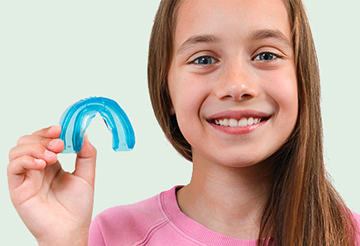
- strength;
- elasticity;
- elasticity;
- biological compatibility with all tissues;
- does not affect the chemical metabolism in the body;
- hypoallergenicity.
Elastopositioners are worn to correct an overbite. If you use other designs together with them, the time to correct violations is reduced.
Indications for wearing the device:
- crossbite;
- narrowing of the dental arches in the area of molars and premolars;
- fixing the result after adjustment with non-removable structures;
- correction cosmetic defects dentition.
But it is not always possible to use the design, there are contraindications:
- Skeletal anomalies.
- Respiratory disorders (patient breathes through the mouth).
- gum hypertrophy.
- Kidney pathology - dystopia.
The use of elastic positioners is limited if there are:
- breathing problems when the patient breathes through the mouth;
- joint diseases;
- short frenulum of the upper lip;
- gum bleeding.
The device does not need to be worn all the time. It is enough to use it at night.
In difficult cases, elastopositioners are worn during the day for 2-4 hours. Getting used to the device lasts about a week.
Aligners
 Transparent mouthguards, which are made according to casts of the patient, are called aligners. They must be constantly changed. The effectiveness of the design is achieved by regular replacement of the mouth guard.
Transparent mouthguards, which are made according to casts of the patient, are called aligners. They must be constantly changed. The effectiveness of the design is achieved by regular replacement of the mouth guard.
Advantages of aligners:
- transparency - they are invisible on the teeth;
- do not cause allergies;
- comfortable use.
Cons of aligners:
- high price;
- weak fixation.
Veneers and Lumineers
There are devices that can only visually correct the wrong bite. These include veneers and lumineers. These devices are most often used to create perfect smile.
These devices look like thin plates. They are made of porcelain or zirconia.
Indications for the use of veneers and lumineers:
- dark spots on the teeth - they even out the color of the crown;
- staining of teeth in dark shades associated with a high concentration of tetracycline in the body;
- fragility of teeth, leading to their thinning, abrasion;
- chips and irregularities of the crown;
- gaps between teeth;
- age-related changes in enamel;
- underdeveloped teeth;
- displacement and twisting.
They are installed if there is no caries and the enamel of the crowns is not too thin. Veneers and Lumineers are an alternative to teeth whitening. The advantages of the method are painlessness. In addition, over time, the fixtures do not darken.
The disadvantage of the device is increased fragility. It is due to the fragility of the material.
The main difference between the devices is the thickness of the overlays. Lumineers are thinner than veneers. Despite this, Lumineers are durable. This is due to a tighter fit to the tooth than veneers. It takes 2 visits to the orthodontist to install lumineer onlays. Veneers are fixed in several visits. They require grinding of the teeth before the procedure.
Lumineers are a modern replacement for veneers, but lumineers are several times more expensive and have more advantages. If the patient has minor gaps in the dentition, veneers are suitable. For creating " Hollywood smile”, the orthodontist recommends Lumineers. Life after braces: removal of the system and subsequent dental care
No comments yet
healthy, beautiful and straight teeth is the dream of every person. Few can boast of the perfect smile that nature has given. More often you have to spend time, effort and money on the process of straightening your teeth. Why sometimes teeth grow crooked, how you can fix it at home, is there an alternative to braces - we'll talk about this in detail.
Why do teeth sometimes grow crooked?
By nature, a smooth and beautiful dentition is not very common. For what reason does it start to grow crookedly, is it possible to avoid this? Such problems "come from childhood." Among the factors leading to the fact that the smile becomes crooked and far from ideal, the following can be distinguished:
Some parents assume that crooked teeth in a child may eventually straighten themselves. No doubt this is far from true. If there is a problem with the bite, by itself it will not disappear anywhere, but will only progress. Another nuance - the ideal row of milk teeth does not guarantee that the permanent ones will also be even, and a violation of the temporary bite always leads to the fact that there will also be problems with the permanent ones.
Ways to correct the dentition
 Many are sure that the alignment of teeth involves the need to grind or push them apart, you need to undergo a sawing procedure or wear ugly pieces of iron. It is advisable to start working on correcting the bite and aligning the teeth in childhood, when skeletal system not yet fully formed, and remains quite supple. In this case, the result will be achieved much easier and faster.
Many are sure that the alignment of teeth involves the need to grind or push them apart, you need to undergo a sawing procedure or wear ugly pieces of iron. It is advisable to start working on correcting the bite and aligning the teeth in childhood, when skeletal system not yet fully formed, and remains quite supple. In this case, the result will be achieved much easier and faster.
There is no consensus on how old you can be to straighten your front teeth. Orthodontists believe that the optimal childhood age is 6 years, but some of them suggest that it is better to postpone the procedure for a couple of years. Teeth alignment is done in the same way, regardless of the age of the patient - the differences are some nuances. How to straighten your teeth? It makes sense to use one of the following ways and methods.
| Ways to straighten teeth | Varieties | Notes |
| Bracket systems |
| The most popular way. A bracket system is the same piece of iron that is worn on the dentition. Allows you to achieve an almost perfect bite. Aligning teeth takes from six months to three years. |
| Veneers |
| Veneers are thin shells that are attached to the front surface. Overlays are used in aesthetic dentistry. The bite cannot be corrected with veneers (they do not eliminate defects, but mask them, you can see the name addsite), but it is possible to achieve a perfect smile in a short time. The disadvantage of veneers is the need for a small grinding of the teeth for their installation. |
| Removable orthopedic devices |
| Often used to straighten teeth in children. For adults, it is recommended to use them after the correction of the dentition with a bracket system in order to consolidate the result. |
| Trainers |
| They are a kind of "simulator" for facial muscles. It is effective if minor bite defects need to be corrected. |
| Surgical intervention | - | With an open lateral or frontal bite or dysplasia of the lower jaw, a surgical operation by alignment. It is performed under general anesthesia. |
Alignment at home
According to dentists, the alignment of teeth (canines or incisors) on their own, without the help of an orthodontist, is impossible.
To choose the right teeth alignment technique, get necessary consultations according to the peculiarities of carrying out procedures and monitoring the progress of the process, you still have to visit the dental office - and more than once.
However hospital treatment in the vast majority of cases, it is not required - it is quite possible to align the dentition at home. If braces are contraindicated for any reason, or the patient categorically objects to their use, it is possible to align the teeth without braces.
Records
How to carry out the procedure for straightening teeth at home? One of the most popular species straightening teeth - use plates to correct the bite. In terms of prevalence, this technique ranks first among the methods of effective alignment of teeth without braces. The plates show high reliability when it is necessary to slightly align the teeth (canines or incisors) and correct the bite in children and adolescents up to 15-16 years old. In more late age they can be used to fix the effect obtained when wearing the braces. Plates are made in two varieties:
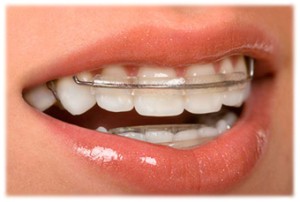
Trainers
Another effective solution for a person who cannot or does not want to wear braces, use silicone trainers. Teeth alignment devices for children and adults look like translucent boxing mouthguards. Bite correction using this device is indicated in the following cases:
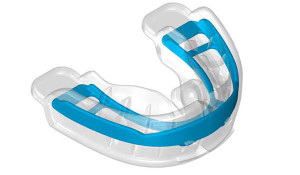
Trainers are straighteners that have a very gentle effect, and the process of teeth alignment is almost imperceptible to the patient. It is not necessary to wear a trainer constantly to straighten the dentition (when we are talking about the child) - a few hours a day are enough. For tooth enamel, such devices are absolutely safe, they are very easy to use, and besides, trainers are easy to maintain and are relatively inexpensive. With all the advantages of the technique, in some cases its use is contraindicated:
- serious anomalies of dental occlusion, including genetic ones;
- increased bite of the lateral sections;
- severe nasal congestion.
Silicone caps
To correct teeth without braces, you can use mouth guards. Mouthguards for aligning teeth can be polyurethane, silicone. The latter are cheaper, but differ in greater thickness
At their core, they are a type of silicone braces. Such designs are put on at night, and during the day they are worn for several hours. It is possible to eliminate minor bite defects, get rid of crowding or displacement, eliminate interdental spaces with the help of silicone caps. To achieve straight teeth, you will need to change many sets of silicone "braces", and this is not cheap.
Massage methods
To align teeth with slight curvature, the dentist may recommend techniques special massage. In domestic dental practice, this method of teeth alignment is not very common, as it shows no high efficiency and requires long and regular procedures. At home, with the help of massage, a slightly curved dentition is straightened. Often massage is not recommended as independent technique teeth alignment, but as an addition to one of the options listed above. It is better to consult a dentist about massage methods for straightening teeth at home.
Can adults straighten crooked teeth?
Aligning crooked teeth in a person older than 25 years is not only possible, but necessary. Bite defects negatively affect the beauty of a smile, in addition, they lead to rapid wear of the teeth due to uneven distribution of the load. For this reason, it is important to keep your teeth straight. AT adulthood the skeletal system is already formed, and a person approaches the alignment procedure consciously and responsibly, therefore modern systems and teeth alignment techniques show high efficiency when used in people of almost any age.
Of course, in a few minutes it is impossible to make the dentition even without time and effort - even the installation of veneers will take several weeks, but the result is worth the effort and it is possible to achieve the effect without using braces. Even more answers to the question of how to straighten your teeth at home are presented in the video below.
There are many reasons for crooked teeth. Since this problem is not only an aesthetic one, many people would like to fix it. Of course, in childhood the effectiveness of treatment is much higher. Although the most popular method of correction - the installation of hard metal plates (braces) is not suitable for babies. By the way, few adults also agree to wear this design. So can you straighten your teeth without braces?
Causes of crooked teeth
Today, dentists identify three main factors for impaired development of the chewing apparatus. First, this genetic causes. Secondly, - bad habits e.g. permanent presence in the mouth foreign objects, the habit of the nipple in an infant, the pressure of the tongue on the dentition.
Today you can straighten your teeth without braces at absolutely any age.
Finally, last reason this misfortune will be a violation physiological respiration nose. When it occurs through the mouth, the tip of the tongue, which in its natural physiological position is pressed against the palate, descends. This leads to deformation upper jaw and developmental defects.
As a rule, all such problems can be identified at a very early age. Experts recommend that you first eliminate the cause, and then proceed with the correction of teeth.
But it is impossible for babies to wear braces, since the jaw is still being formed, and a rigid system can interfere with its normal development. Today, this problem has been completely solved, and doctors confidently declare that straightening teeth without braces is a reality.
Ways of correction in children
Crooked teeth can lead to cavities and other oral diseases. After all, when one tooth comes over another, the opportunity disappears. complete removal food debris between them, which, in turn, provokes the growth of bacteria and damage to the enamel. As a rule, the change of the chewing apparatus begins at the age of about six years. It is at this time that you need to visit a specialist who can diagnose possible defect and help fix it.
Since the problem can be corrected better in young children than in adults, orthodontists recommend starting treatment immediately after identifying the trouble.
However, as we mentioned above, rigid adjustment systems are contraindicated up to a certain age. Although correcting crooked teeth without braces in babies is quite possible.
Impact plates
The first way will be to make an overlay for the sky. For its production, you will need to make an impression, since each product is made individually. This special plate is made from dental polymers and serves to widen the jaw. In some cases, parts are made to help slow down growth or contribute to the narrowing of the jaw.
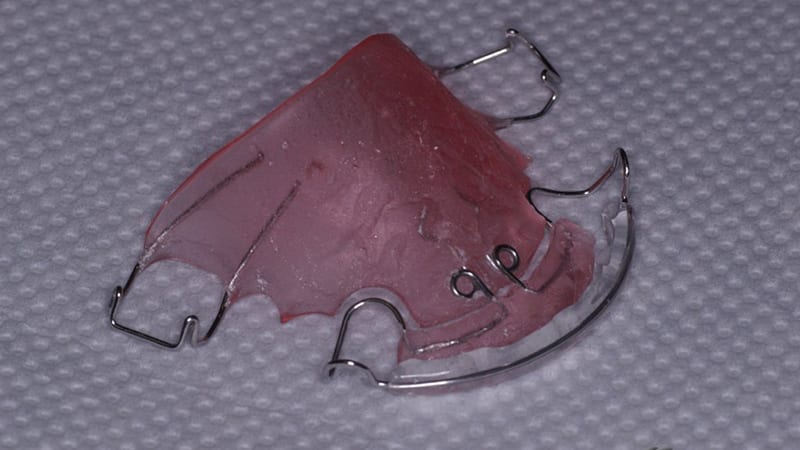
To correct crooked teeth in childhood, a plate made of rigid polymers with metal elements can be used.
In addition, the plates are equipped with metal elements and screws fixed to their base. This will help in such cases as correcting a crooked tooth without braces when normal development the rest of the row. Such devices are removable, but require permanent wear. It is recommended to remove them during meals and oral hygiene. You will also need regular visits to a specialist to constantly correct the position of the tooth and the wire that aligns it.
Elastic overlays
The next option, how to straighten your teeth without braces, will wearing trainers. Unlike the first option, this is a serial production. The product is a soft plate made of elastic polymers that adapt to the shape of any jaw. Usually trainers are worn on both jaws, and not just on the upper one, like plates. There are such varieties:
- preorthodontic, used to correct an overbite;
- articular, used to reduce the pressure of the masticatory muscles on the dental apparatus;
- finishing retainer, installed after wearing braces to fix the result;
- sports, used to protect the jaw in extreme sports.
There is also a model for the simultaneous wearing of braces. It is advisable to put trainers in cases of nasal breathing disorders, since they help the tongue to take the correct position and contribute to the expansion of the jaw.
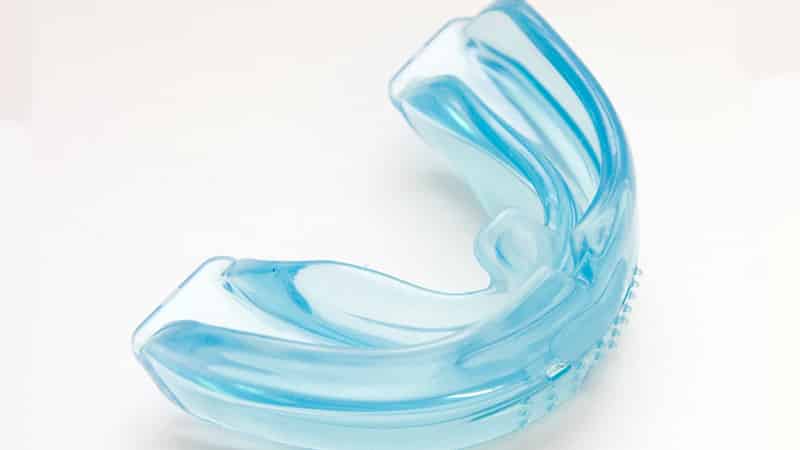
Enough effective correction teeth can be achieved by wearing trainers
The mechanism of action of this device is such that it affects only chewing muscles without exerting a mechanical effect on the dentition. Therefore, with this product Correction of teeth without braces becomes very effective. In addition, the wearing of these plates contributes to the solution of speech therapy problems with speech and weaning from the constant presence of foreign objects in the mouth. On average, the course of wearing a starting trainer is from six months, and a finishing one from eight.
These alternative ways Aligning teeth without braces in a child is popular today because they have proven themselves well. Now let's look at the solutions similar problems in adults.
Alternatives to braces for adults
As is known, the formation human body completed at the age of twenty-five. After this age, the bones become fixed and lose their mobility. It is for this reason that the alignment of teeth in adults looks like a difficult task. Braces are often the solution. However, there are cases when, for some reason, wearing them is impossible. Therefore, many people are interested Is it possible to straighten teeth without braces in adulthood. Today's development of science and technology makes it possible to do this. First, you can try to correct the defects. Secondly, there is the possibility of masking crooked teeth to improve aesthetics with their gradual restoration.
Correction of the dentition
So first possible way how to straighten teeth without braces will be wearing caps. These devices are made according to an individual mold from polymers that are safe for health. Since the plates are completely transparent, their presence is visually imperceptible.
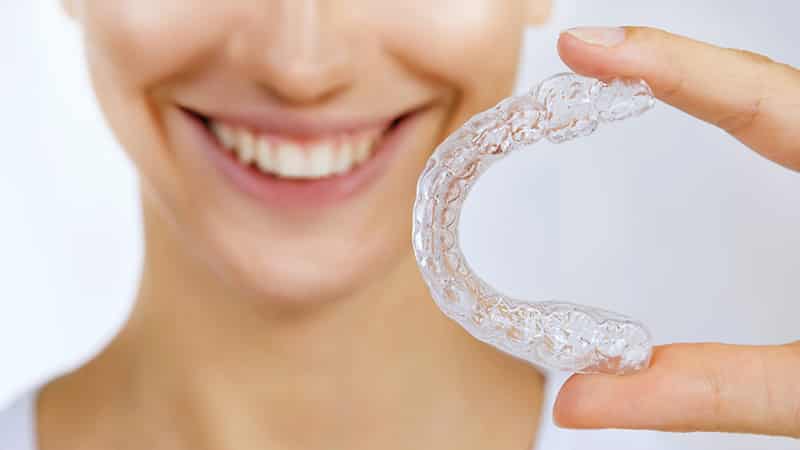
Wearing a mouthguard is almost imperceptible to others
As a rule, the alignment of the front teeth in an adult occurs in several stages. Therefore, it will be necessary to develop a series of plates in order to completely correct the existing defect. Keep in mind that this removable device will have to be worn for quite a long time. Based on the nature of the problem and the degree of its severity, mouthguards will correct the bite within a few months, and in especially advanced cases - even two years. Usually wearing the device is indicated in such cases:
- crossbite;
- twisting or turning;
- different height;
- large gaps in the dentition;
- close location.
As you can see, their scope is quite extensive. However, this is not full list the merits of such a device. Mouthguards do not cause significant inconvenience to the patient - getting used to the device takes two days, the device does not disturb speech and does not deliver pain. In addition, they are easy to care for.
A more innovative solution to such a problem, how to align teeth without braces in adults, will be an analogue of the above design - aligners. These plates are an improved copy of cap. They help the specialist to constantly monitor the movement of the teeth and correct them in the right direction. Each such element is developed individually using 3-D modeling, which guarantees the highest accuracy of the system. Perhaps the only drawback will be the high cost of these structures.
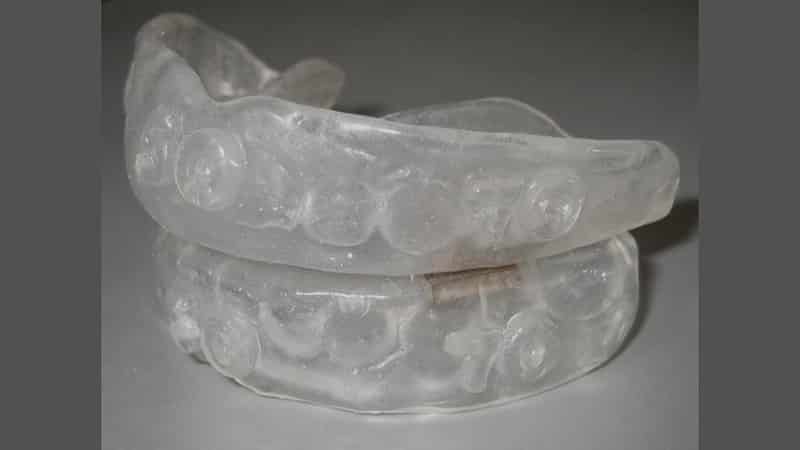
Elastopositioners quite effectively align teeth even in advanced cases
Excellent efficiency in such a difficult case, straightening teeth without braces for adults, was shown elastic positioners. These devices will help to correct even quite neglected problems, since they allow you to move the tooth up to 4 millimeters. The material for the manufacture of such structures is a durable and elastic material - vinyl-silicone. It is its elasticity that allows you to solve the following tasks:
- correction of malocclusion;
- alignment of the dentition;
- elimination wrong position individual tooth.
All devices are removable and are made on the basis of an individual cast. Usually, the period of putting on the device is limited to night sleep and several hours during the day. Elastopositioners will not cause you any discomfort during treatment, and getting used to them, as a rule, occurs within seven days. Perhaps that's all ways to, How can you straighten your teeth without braces today. However, there are still methods of visual correction and simultaneous restoration.
Modern camouflage technologies
Unfortunately, not always methods of teeth straightening can be applied for one reason or another. Sometimes an anomaly simply cannot be corrected, but there are cases with the occurrence allergic reaction the patient on the materials for making the plate or an impressive list of contraindications for such therapy. AT similar situations the best solution would be to install veneer. This piece of ceramic or composite is installed on a tooth pre-treated by a specialist and fixed on it.
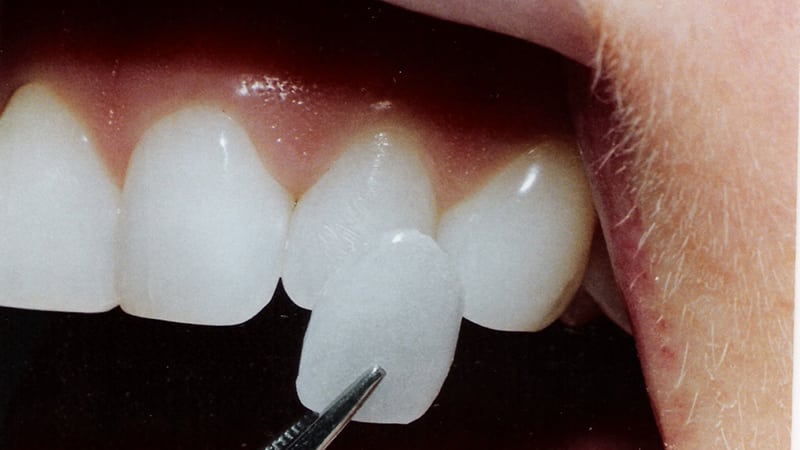
Straightening teeth with veneers
Veneers hide chips and developmental defects, wide gaps in the dentition and can visually adjust the size of the tooth. Of course, the installation of the device is a rather lengthy process. The production of the model takes about 14 days and will require several visits to the dentist to grind the enamel. However, the advantage of installing the device will be the relatively low cost of the procedure and the ability to accurately match the color of the imitation to the tone of the rest of the dentition. The service life of the structure reaches up to ten years, depending on the material used and the method of installation.
A more costly option would be to use Lumineers. This method is completely similar to the previous one, but does not require tooth processing. This means that you can remove the device at any time without additional procedures recovery. Lumineers are made exclusively from ceramic materials with a plate thickness of 0.2 mm. It will take about a month to make an imitation
As far as you have noticed, there are many solutions to such a problem as how to fix teeth without braces. Of course, each case is individual and requires a particularly thorough examination by a qualified dentist in order to make an informed decision. However, when doing this, keep in mind that innovative technologies allow you to choose the most suitable and convenient option.
The installation of lumineers does not require tooth processing and subsequent restoration. Development of an individual device for alignment based on a jaw impression. Aligners are an improved analogue of a mouth guard. using trainers To correct crooked teeth in childhood, you can use a plate made of rigid polymers with metal elements Today, you can straighten your teeth without braces at absolutely any age
Malocclusion usually manifests itself in childhood. Therefore, if parents did not pay attention to the problem in time, in adulthood the teeth will need a special approach. In general, dentists identify several main mistakes that affect the beauty of teeth.
- Self-correction of teeth at home with improvised means. This can end badly, even on a surgical table.
- Late visit to the doctor. As soon as you find a cause for concern, even if it is imaginary, go to the doctor.
- Extraction of a tooth without consulting a dentist. Extraction of teeth is possible only in dental office and after a thorough examination, because you can get rid of a living tooth.
- Reluctance to remove milk teeth. If the doctor recommends removing the child baby tooth to correct the bite - agree.
How to straighten your teeth at home?
Nevertheless, it is possible to do everything possible for your bite at home. In addition, the concept of "fix at home" involves a visit to the doctor, but does not involve huge spending on medical services. You won't have to wear braces, but you will need to turn to alternative technologies.
Trainers
This is the most effective method for straightening children's teeth. In fact, each clove is placed in silicone cases, combined with each other. There is also a springy arch that affects uneven teeth, gradually straightening them. As soon as they all become even, the bite will begin to correct.
The device is accessible to everyone and can be removed from time to time, besides it is invisible, which is very important for children. But you can use it only with slight curvature. More difficult cases corrected with caps.

Kappas
They can be used not only for the correction of teeth in children, but also in adults. Kappa differ in several features that can be attributed to the benefits. First of all, it is efficiency and harmlessness to enamel. In addition, mouthguards are mainly worn at night, so that during the day a person will not experience discomfort. But, not everything is so pleasant, since this device delivers a lot discomfort, including painful ones.
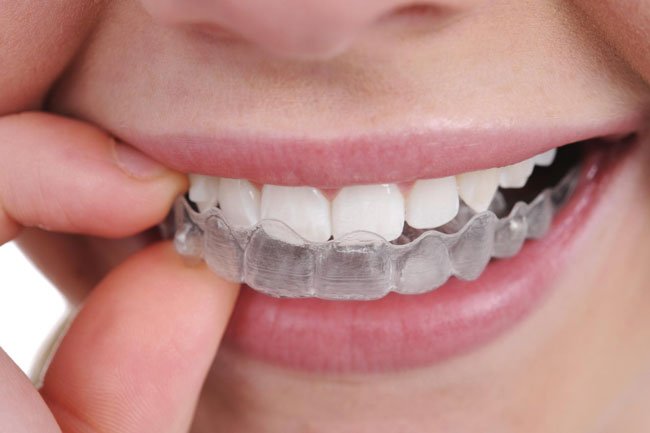
Veneers
This method differs from the previous ones, as it is designed to correct minor defects in one or more teeth that are scattered. The veneer looks like a cap that is put on the tooth, and it becomes completely invisible. Their only drawback is the need to wear constantly. True, their service life reaches ten years.
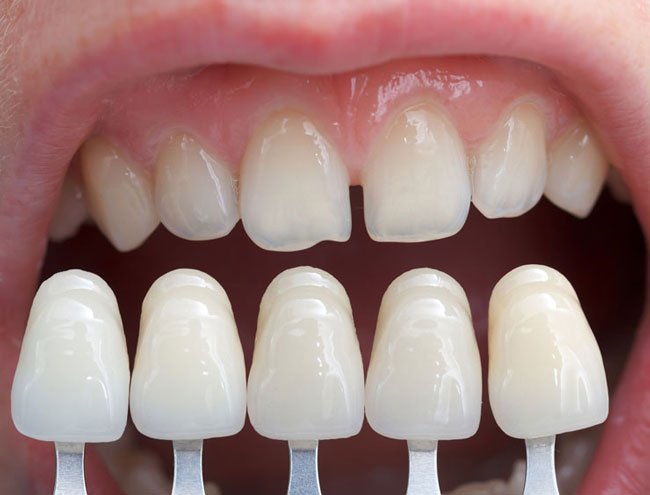
In fact, it is impossible to straighten your teeth at home; anyway, this process involves consulting a doctor. Do not neglect this, because dental problems can worsen and lead to more serious changes in the body. Contact a specialist in time and then treatment is not needed.

